《中西文化对比》第二章 第二讲 汉英文化比较
- 格式:ppt
- 大小:278.50 KB
- 文档页数:26
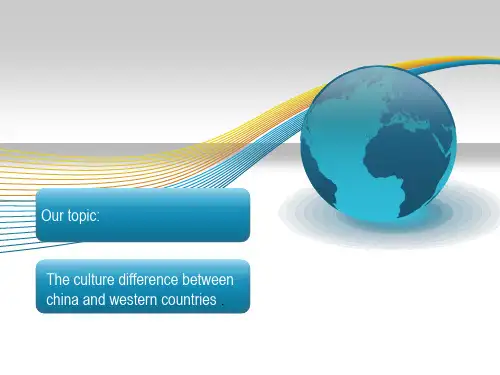
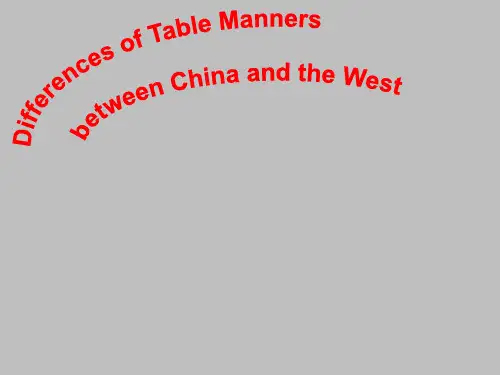
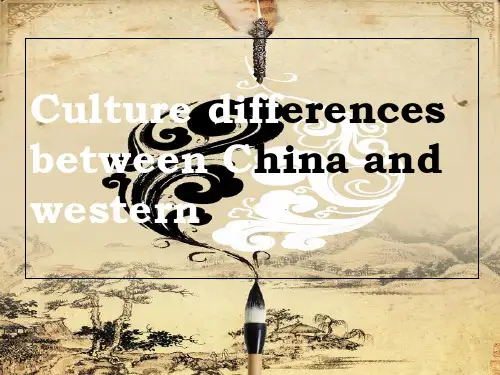
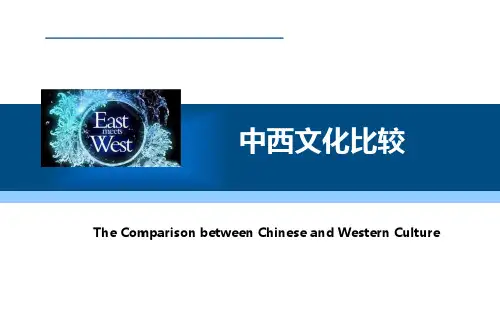
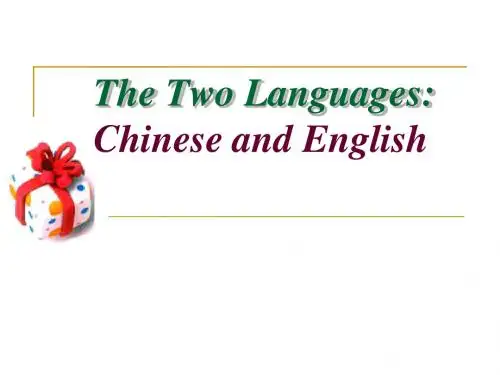
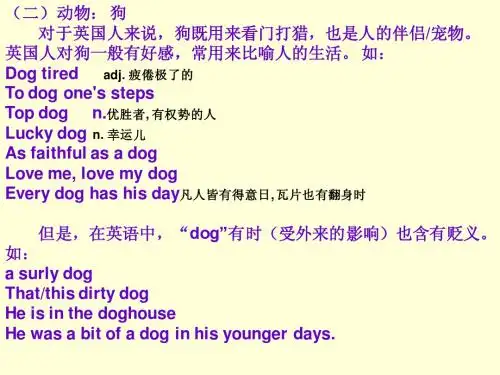
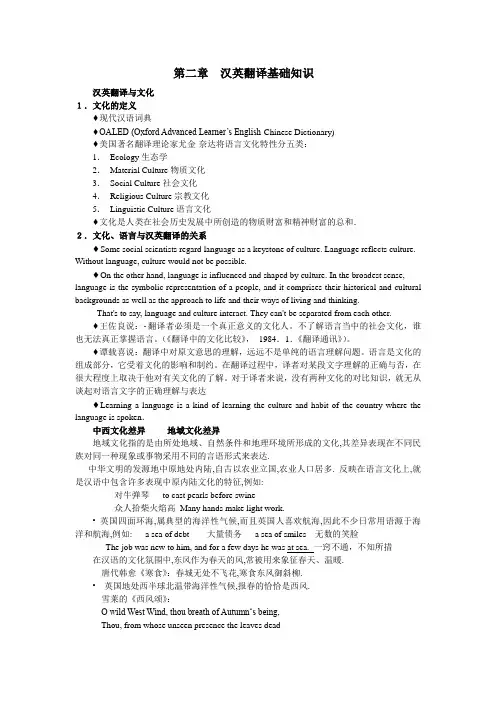
第二章汉英翻译基础知识汉英翻译与文化1.文化的定义♦现代汉语词典♦OALED (Oxford Advanced Learner‟s English-Chinese Dictionary)♦美国著名翻译理论家尤金·奈达将语言文化特性分五类:1.Ecology生态学2.Material Culture物质文化3.Social Culture社会文化4.Religious Culture宗教文化5.Linguistic Culture语言文化♦文化是人类在社会历史发展中所创造的物质财富和精神财富的总和.2.文化、语言与汉英翻译的关系♦Some social scientists regard language as a keystone of culture. Language reflects culture. Without language, culture would not be possible.♦On the other hand, language is influenced and shaped by culture. In the broadest sense, language is the symbolic representation of a people, and it comprises their historical and cultural backgrounds as well as the approach to life and their ways of living and thinking.That's to say, language and culture interact. They can't be separated from each other.♦王佐良说:翻译者必须是一个真正意义的文化人。
不了解语言当中的社会文化,谁也无法真正掌握语言。
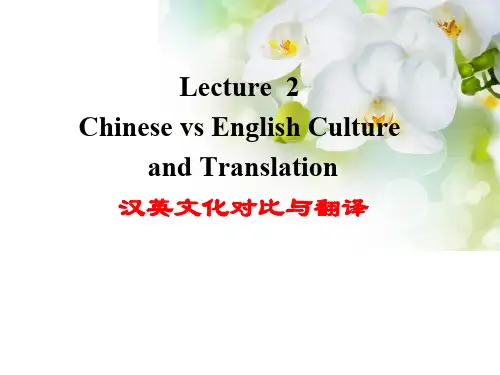
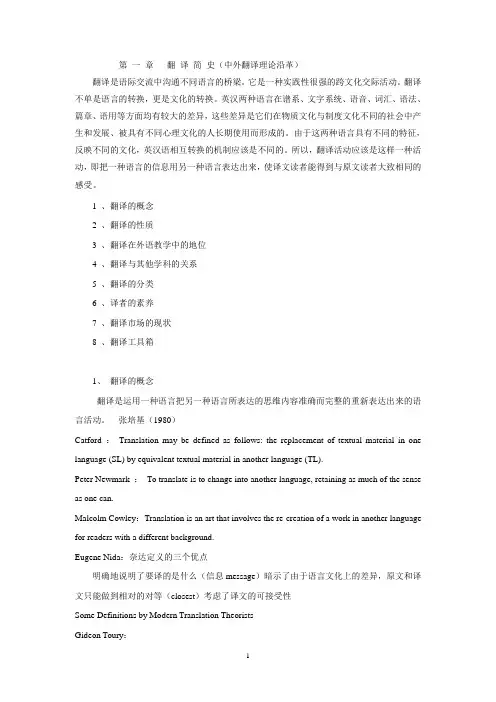
第一章翻译简史(中外翻译理论沿革)翻译是语际交流中沟通不同语言的桥梁。
它是一种实践性很强的跨文化交际活动。
翻译不单是语言的转换,更是文化的转换。
英汉两种语言在谱系、文字系统、语音、词汇、语法、篇章、语用等方面均有较大的差异,这些差异是它们在物质文化与制度文化不同的社会中产生和发展、被具有不同心理文化的人长期使用而形成的。
由于这两种语言具有不同的特征,反映不同的文化,英汉语相互转换的机制应该是不同的。
所以,翻译活动应该是这样一种活动,即把一种语言的信息用另一种语言表达出来,使译文读者能得到与原文读者大致相同的感受。
1 、翻译的概念2 、翻译的性质3 、翻译在外语教学中的地位4 、翻译与其他学科的关系5 、翻译的分类6 、译者的素养7 、翻译市场的现状8 、翻译工具箱1、翻译的概念翻译是运用一种语言把另一种语言所表达的思维内容准确而完整的重新表达出来的语言活动。
---张培基(1980)Catford :Translation may be defined as follows: the replacement of textual material in one language (SL) by equivalent textual material in another language (TL).Peter Newmark :To translate is to change into another language, retaining as much of the sense as one can.Malcolm Cowley:Translation is an art that involves the re-creation of a work in another language for readers with a different background.Eugene Nida:奈达定义的三个优点明确地说明了要译的是什么(信息message)暗示了由于语言文化上的差异,原文和译文只能做到相对的对等(closest)考虑了译文的可接受性Some Definitions by Modern Translation TheoristsGideon Toury:―A translation is taken to be any target-language utterance which is presented or regarded as such within the target cultur:e, on whatever grounds.‖Christiane Nord―Translation is the production of a functional target text maintaining a relationship with a given source text that is specified according to the intended or demanded function of the target text.‖Jean Sager:―Translation is an externally motivated industrial activity, supported by information technology, which is diversified in response to the particular needs of this fo rm of communication.‖吕俊:―翻译是一种跨文化的信息交流与交换活动,其本质是传播,是传播学中一个有特殊性质的领域。
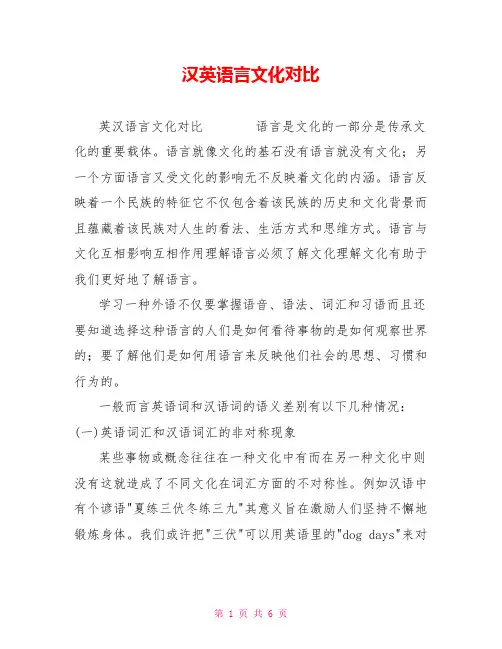
汉英语言文化对比英汉语言文化对比语言是文化的一部分是传承文化的重要载体。
语言就像文化的基石没有语言就没有文化;另一个方面语言又受文化的影响无不反映着文化的内涵。
语言反映着一个民族的特征它不仅包含着该民族的历史和文化背景而且蕴藏着该民族对人生的看法、生活方式和思维方式。
语言与文化互相影响互相作用理解语言必须了解文化理解文化有助于我们更好地了解语言。
学习一种外语不仅要掌握语音、语法、词汇和习语而且还要知道选择这种语言的人们是如何看待事物的是如何观察世界的;要了解他们是如何用语言来反映他们社会的思想、习惯和行为的。
一般而言英语词和汉语词的语义差别有以下几种情况:(一)英语词汇和汉语词汇的非对称现象某些事物或概念往往在一种文化中有而在另一种文化中则没有这就造成了不同文化在词汇方面的不对称性。
例如汉语中有个谚语"夏练三伏冬练三九"其意义旨在激励人们坚持不懈地锻炼身体。
我们或许把"三伏"可以用英语里的"dog days"来对应那么在英语里就很难找到与"dog days"一样有形象意义的词来与"三九"对应了。
英语文化内涵颇为浓厚cowboy在汉语中没有意义对应的词因为这个词是美国社会特有的产物。
cowboy与美国早期开发西部地区有关关于他们的传说总带有浓厚的浪漫主义和传奇色彩。
在汉语中有很多这样的词如"牧童"、"羊倌"和"牧马人"但这些都是田园牧歌中的人物形象。
虽然我们从港粤借来"牛仔"一词与之呼应并且这已成为主流和经典的译法但是英语"cowboy"中所传承的美国西进运动中那批拓荒者的英雄气概与传奇风采始终没有传达出来倒徒增了几分只对于凡夫俗子的调侃之意;比如"打工仔"就是一个明证。
(二)英语词汇和汉语词汇的不等值现象在不同的文化背景里往往会对共同的事物和现象有一个认识但是毕竟是在不同的文化圈里所以看似差不多的词汇其实往往出现了因文化差异而形成种种不等值现象。
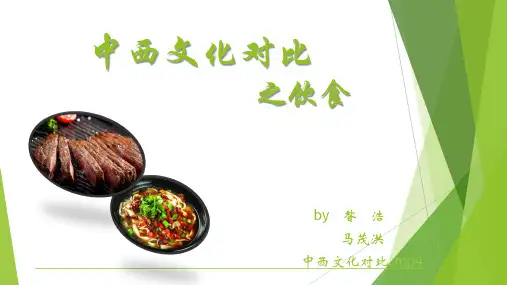
It is also appropriate to ask how they prefer to be addressed. Children should always address adults in the formal fashion, using their title and last name. Another difference is about the form of addressing. From the viewpoint of sociolinguistics, forms of addressing can serve as an indication of the relationship of power and solidarity in the society. In calling their superiors or elders, the Chinese are accustomed to the nonreciprocal or asymmetrical addressing, in other words. They use “title +surname” to address their superior or elders rather than call them surnames, while the superior or elders call the addressers their names. The Chinese tend to abide by the polite principle of depreciating oneself and respecting others to show appropriate respects towards the persons being addressed, otherwise, the addresser may be considered as ill mannered, ill educated or rude. But in English speaking countries, people have a tendency to follow the reciprocal or symmetrical addressing. Although they are different in age and status, they can call the other directly, namely, their names, even first names except when they call the doctors, not arousing offence between them, but demonstrating the sense of intimacy and the conception of” Everyone is created equal” . Chi nese people feel unnatural addressing a westerner by his given name, feeling that it indicates too close a relationship, and westerners, on the otherhand, may feel that if a Chinese insists on using his surname, it indicates an unwillingness to be friendly and maintains a gap between them. So the use of forms like” Miss Mary” or “Mr. Smith ” may be a Chinese forms of compromise. With Miss Mary, the use of the given name indicates friendliness, but the addition of the title indicates the respect they feel they ought to show. And with Smith, the lack of a title indicates friendliness, but the use of the surname prevents if sounding too intimate. However, both addressing used by the Chinese sound very strange and uncomfortable to the westerner. pliments and ResponseTo compliment is to praise the addressee’s virtues, ability, behavior, appearance, clothing, personality and belongs. Appropriate compliments can serve as effective supplementary means in inter-personal communication. Western and Chinese culture are at polar opposites about compliment. An western hostess, if she is complimented for her cooking skill, is likely to say,” Oh, I am so glad that you liked it. I cook it especially for you.” Not so is a Chinese hostess, who will instead apologize for gi ving you “Nothing”. They will say“随便作几个菜,不好吃。
《中西文化对比》课程教学大纲课程编号:18040162课程名称:中西文化对比学时与学分:32学时/2学分先修课程:大学英语1、2、3册适应专业:大学二年级第四学期非英语专业英语四级成绩为425分以上的本科生教学目的本课程是一门文化知识型,应用型的课程,目的在于:·使学生较深入地了解西方文化,熟悉中国文化,加深对中西方文化体系的认识和比较,增强学生对文化差异的敏感性,以及处理文化差异的灵活性、自觉性;·介绍中西文化传统,风俗习惯,使学生较好地宣传我国文化以增进中西方人们之间的相互了解,从而达到在对外交流过程中准确地理解对方和得体地表达自己;·提高学生文化素养和增强其文化底蕴,增强学生的逻辑思维和独立思考能力,要求学生把握与运用中西文化的比较方法。
教学方法与手段本课程主要采用三种教学方法:演示法,讲授法以及讨论法。
课堂上除了由老师对内容进行讲解,学生也有一定的时间对课堂内容发表个人意见, 展示他们在课后所搜集到的资料。
据本课程的特点,除了采取传统的教学手段:黑板演示外,还会运用多媒体教学技术,活跃课堂气氛,协助课堂内容的清晰阐述。
教学内容1) 中西文化的民族特点文化的定义;中国文化的民族特点;西方文化的特点;高雅文化和通俗文化2) 中西方观念文化比较哲学思想及体系基督教和圣经;基督教在中国的传播佛教与中国文化道教文化伊斯兰教与中国文化伦理道德;审美情趣;民族个性;思维方式3) 中西风俗习惯比较英语国家的节日风情中国传统节日中国婚嫁与葬俗中西社交礼仪中西各民族祥瑞动物崇尚和禁忌4) 中西方物态文化要略建筑艺术风格的比较及鉴赏影视文化中华医学的文化特点中西饮食文化对比5) 汉英语言和文化6) 中西方制度文化比较议会和人民代表大会美国总统选举政党重要国际组织教学方法1) 每大块围绕各主题,通过教师讲座,学生读视听说,培养学生的语言综合能力,提高文化品味,为以后的文化交流打下基础。